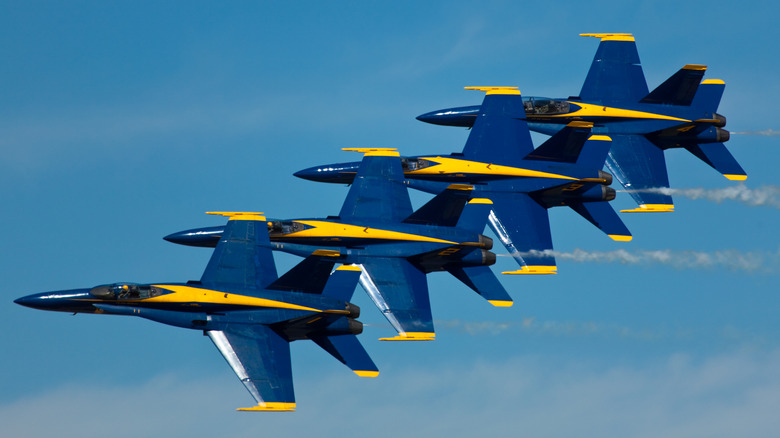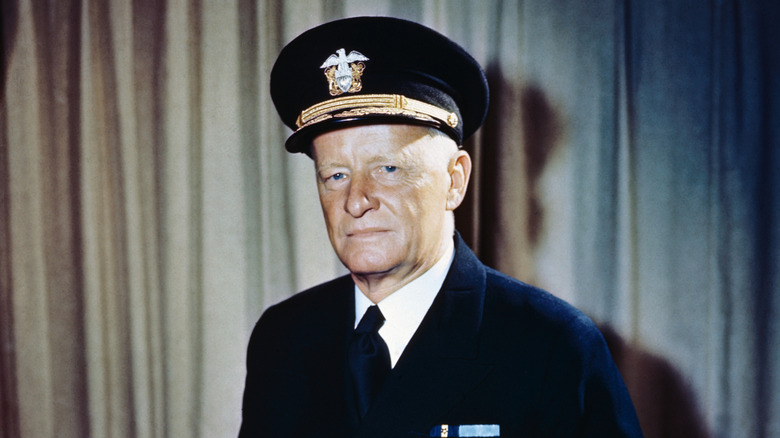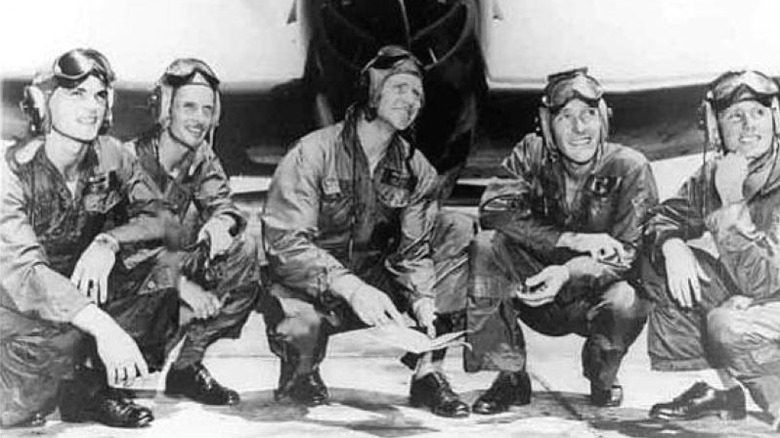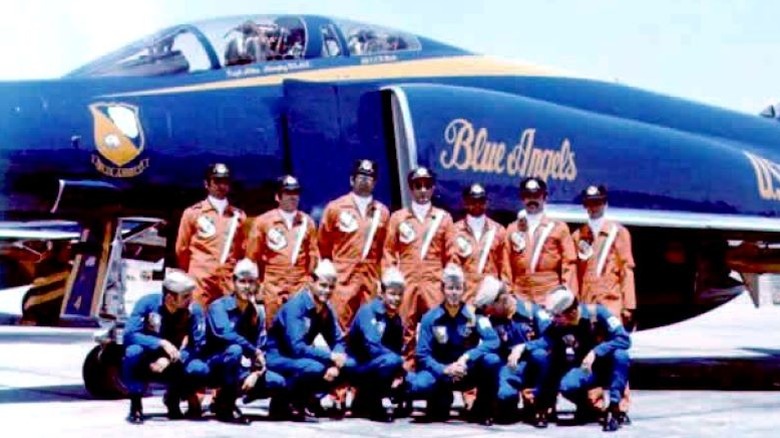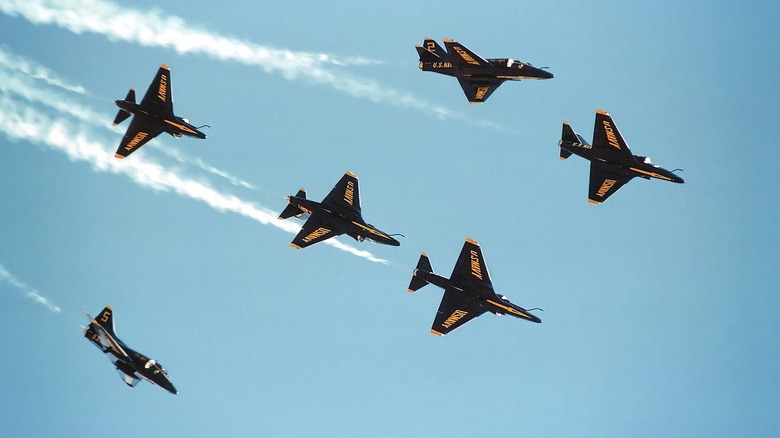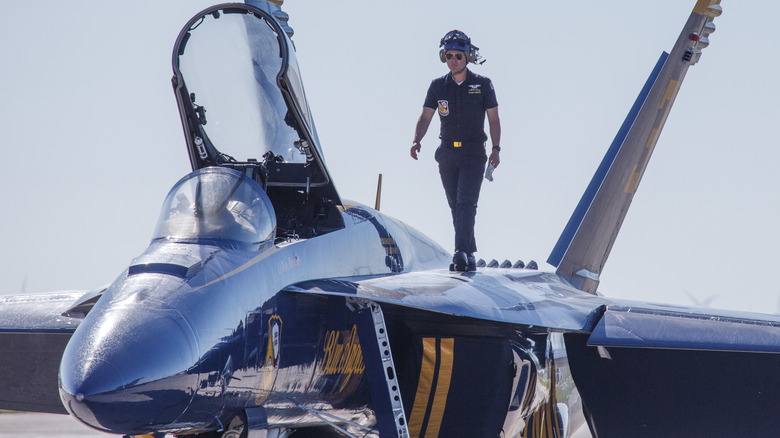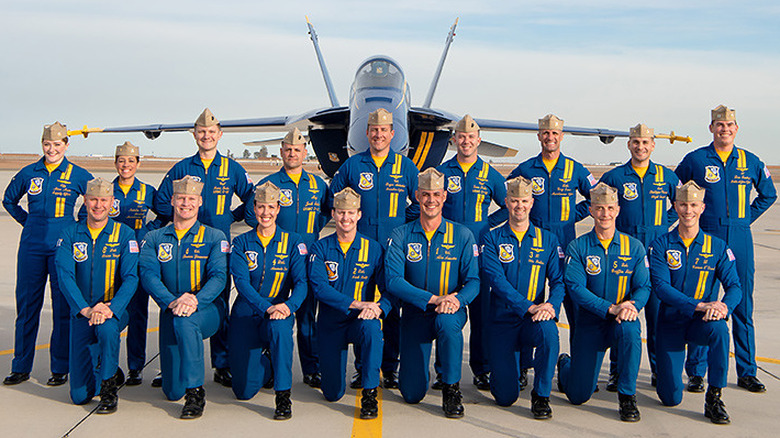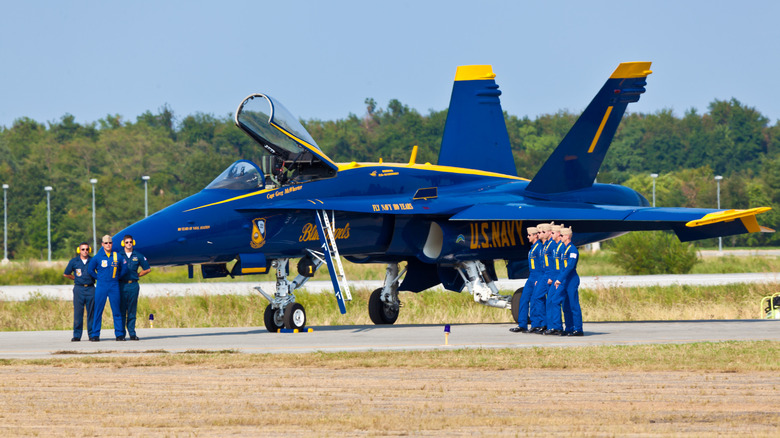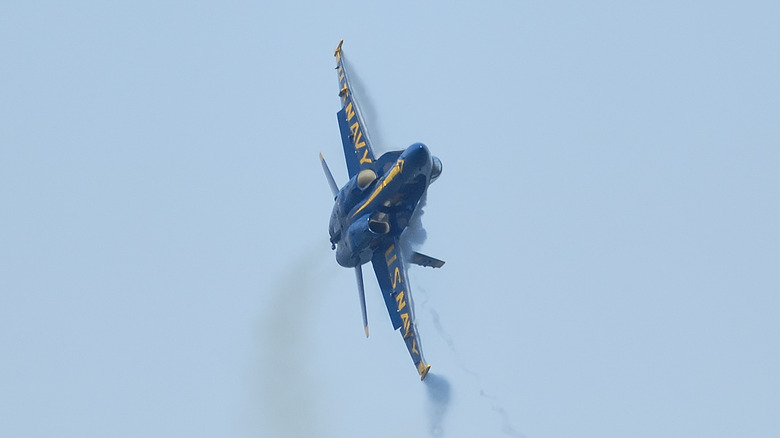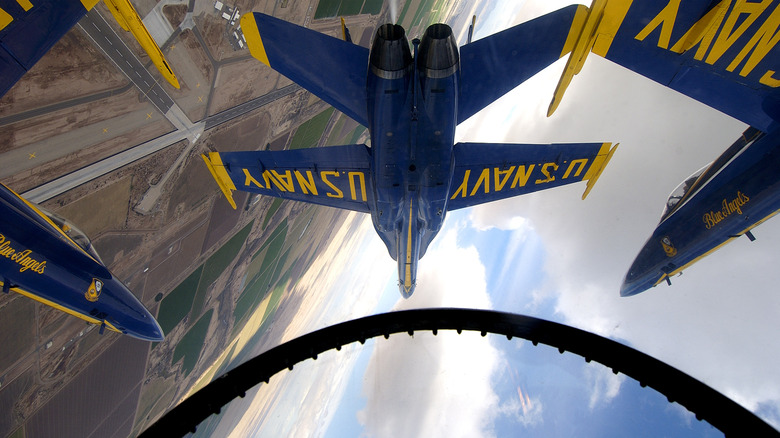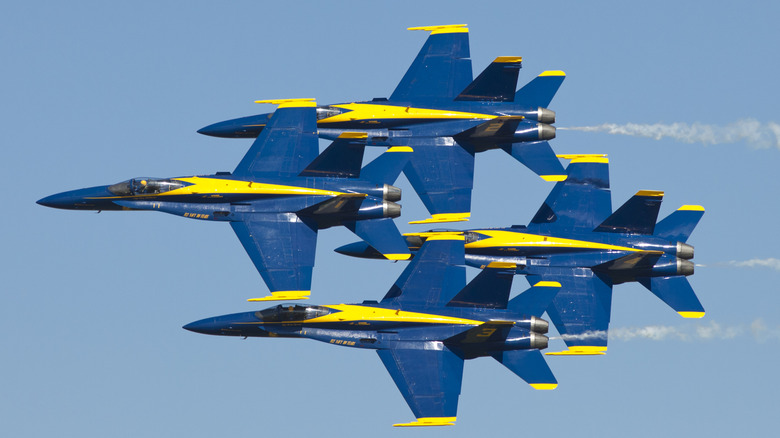Blue Angels: 10 Facts About The Navy's Flying Team
The Blue Angels organization is a proud and historic squad of select flyers, backed by a team of dedicated logistics and public relations professionals. Being chosen as a member of the Blue Angels, whether as a pilot or crew member, is an honor that speaks of exceptional dedication to service in the United States Navy.
The Blue Angel demonstration team has dazzled airshow audiences with state-of-the-art fighter planes and precision flying across the United States and around the world. The flight of elite U.S. Navy pilots headline the show with thrilling high-speed maneuvers and skillful close-formation flying. But the air antics don't show the hard work, dedication, and significant danger endured by members of the organization in its decades-long existence, a testament to their bravery and commitment.
The legendary demonstration team has been drumming up goodwill and showing off the capabilities of the best of the U.S. Navy for years. Join us as we examine the history of the legendary Blue Angels U.S. Navy Flight Demonstration Team.
The mastermind of the Pacific theater created the Blue Angels
Steeped in the history of naval aviation, the Blue Angels demonstration team traces its roots to the closing days of the Second World War. After years of war, the public was eager to turn to peace. Military forces worldwide drew down, and naval pilots settled into the new peacetime normal.
Admiral Chester Nimitz had witnessed the importance and capability of naval flyers as the commander of American forces in the Pacific theater of World War II. He oversaw the campaign, setting strategy as planes launched from aircraft carriers swept the Imperial Japanese military from sea and sky.
After the war, Nimitz became the Chief of Naval Operations. The United States Army Air Corps was on the verge of becoming its own military branch as the United States Air Force, and Nimitz feared naval aviation would fall by the wayside. It was for this reason that he conceived of a flight demonstration team. Part morale booster and part public relations program, Nimitz envisioned it as a method of keeping interest in naval aviation high during peacetime.
On April 24, 1946, Nimitz ordered the U.S. Navy Flight Demonstration Team into existence. Its first task would be to find pilots up to the task. Fortunately, the Navy's ranks swelled with accomplished combat fighter pilots who would embrace the challenge.
The first Blue Angel was an ace pilot
Nimitz's new team required more than crack pilots; the yet-to-be-named Blue Angels needed someone to lead them.
Roy M. "Butch" Voris (center in the photograph) was born on September 17, 1919, in Los Angeles, California. Voris dedicated himself to naval aviation even before the December 1941 attack on Pearl Harbor that drew the United States into the war. He entered the Navy's Aviation Cadet Program on March 1, 1941. He was commissioned as an ensign in February 1942 and trained as a dive-bomber pilot before switching to fighters.
Voris saw his first action flying from the USS Enterprise as a member of VF-10 during the Battle of Guadalcanal. He scored his first aerial victory from the cockpit of a Grumman F4F Wildcat and would go on to achieve seven more victories throughout the war, making him a bona fide fighter ace and a three-time recipient of the Distinguished Flying Cross.
Voris was precisely the type of pilot Nimitz had in mind for his new flight team. Even better, he was still in the Navy, and serving as an instructor at Advanced Training Command in Jacksonville when the Navy tapped him to lead the fledgling demonstration team in 1946.
As the first officer-in-charge, Voris hand-selected the pilots, support crew, and even the aircraft for his team. In June 1946, the U.S. Navy Flight Demonstration team performed its first official show at the Southeastern Air Exposition at Craig Field in Jacksonville, Florida.
The group is named after a nightclub
After the team's successful show at Craig Air Field, Nimitz wanted to examine what he had created. The flight team devised a program that included simulated aerial combat.
A ground crew painted a Texan trainer in Imperial Japanese livery. Dubbed "Beetle Bomb," it would serve as a faux Japanese Zero fighter and engage in a dogfight with the demonstration team. Activating a smoke trail and deploying a dummy attached to a parachute, the demonstration of naval aviation's accomplishments impressed the brass.
With Nimitz's enthusiastic endorsement, the team received an upgrade to its aircraft, transitioning from the Grumman F6F Hellcat to the new F8F Bearcat and going on tour around the country. With its popularity growing, a newspaper at the team's home base in Jacksonville initiated a contest soliciting names for the new team.
Suggestions included "The Cloud Busters," "The Flying Midshipmen," and "The Blue Lancers," but none seemed to capture the right spirit. The official Navy line is the Blue Angels name came from the paint scheme for the aircraft combined with the elite nature of the high-flying team. An alternate version of the story is that early Blue Angel Maurice "Wick" Wickendoll saw an advertisement for the famous Blue Angel Manhattan nightclub and sent it up the ladder, where it was accepted.
Whatever the truth is (we suspect it's a little of both), the Blue Angel name stuck. 75 years later, it is one of the most famous names in military aviation.
The Blue Angels have flown eight different aircraft
The F/A-18 Hornet has been the team's primary aircraft for over thirty years, and is the fighter aircraft most closely associated with the Blue Angels. However, the road to landing on the Hornet was a long one.
The Angels stuck with the Bearcat between 1946 and 1949. The Beetle Bomb aircraft was also updated to the Bearcat, performing solo aerobatics until it crashed in 1950.
With more pilots needed to man the jets that took part in Operation MiG Alley over the skies of Korea, the team went on a brief hiatus before reforming in October 1951, this time flying the F9F-2 Panther. A few years later, the Navy equipped the Blue Angels with the F9F-8 Cougar, which it used between 1954 and 1957, but aviation technology was racing along. In relatively short order, the team went supersonic in the F11F-1 Tiger, a Grumman aircraft perhaps most famous for shooting itself out of the sky.
The Tiger would be the last Grumman aircraft used by the Angels. In 1969, the team switched to the now-legendary McDonnell Douglas F4 Phantom II. Known for its twin-engined power and once shattering hundreds of windows in British Columbia, Canada, when a pilot accidentally broke the sound barrier, the fuel-thirsty Phantom served until 1974.
The Navy switched to the smaller and more practical single-engined Douglas A4 Skyhawk between 1974 and 1986, when it finally transitioned to the F-18, which has been its primary ride ever since.
The road to becoming a Blue Angel pilot is long
Becoming a Blue Angel pilot is an extraordinary achievement. The role carries the weight of the lives of teammates and spectators, a responsibility that only the most skilled and dedicated aviators can handle.
The Blue Angels select four pilots each year: three for the F/A-18 demonstration team, and one to fly the Marine Corps C-130 support craft, Fat Albert. Fierce competition among career aviators guarantees the organization has no shortage of applicants.
The barest requirements dictate that a Blue Angel is a carrier-qualified U.S. Navy or U.S. Marine Corps pilot. The road to becoming a carrier-certified fighter pilot alone is long and strenuous. The first step is to obtain a four-year college degree and be commissioned as an officer in the Navy or the Marines.
Becoming a fully certified fighter pilot is a rigorous, multi-year journey that demands both academic and physical excellence. Those who succeed in this demanding process will join a functional squadron, where they must accumulate a minimum of 1,250 tactical flight hours before they can even consider applying to the Blue Angels.
Blue Angels pilots are not just excellent fighter pilots. They are also global ambassadors, representing the U.S. Navy with the highest standards of the military, both in and out of uniform. It's a role that carries immense pride and responsibility.
The Blue Angels team has more than just pilots
Transporting, promoting, and maintaining a fighter jet flight is a feat that requires the expertise and dedication of dozens of trained specialists. The program draws 17 commissioned officers and over 100 enlisted personnel from the Navy and Marine Corps, each bringing their unique skills and commitment to the table.
The Chief of Naval Air Training plays a crucial role in the Blue Angels team, particularly in the selection of the commanding officer, known as the "Boss." This officer, in addition to overall command, flies the number 1 jet in demonstrations. The selection process for this role is rigorous, with basic requirements including experience commanding a tactical jet squadron and 3,000 hours of flight time. Non-flight officers bring expertise in various naval specialties, including administration, medicine, public affairs, and maintenance.
All members undergo an exhaustive screening process, a testament to the high standards and professionalism of the Blue Angels team. This process ensures their capability of upholding the Navy's highest standards around the world. The enlisted team operates under the direction of a senior enlisted sailor and includes mechanics and avionics experts, crew chiefs, and event coordinators.
You might think that service as a Blue Angel team member is a career-long commitment. After all, the skill and dedication required demands thousands of hours of intense training. But the truth is, a tour in the Blue Angels is a temporary assignment that only lasts a few years.
Blue Angel F/A-18 Super Hornets are top-tier jets
Though the Blue Angels have used the F/A-18 Hornet for over thirty years, the fighter aircraft is still an essential part of the American arsenal. The fourth-generation carrier-based jet can serve in air superiority or ground attack roles in support of operations worldwide.
In 2020, the Blue Angels transitioned to the updated Super Hornet. Propelled by a pair of General Electric F414-GE-400 turbojet engines, each capable of producing up to 22,000 pounds of thrust, the Super Hornet can reach a maximum speed of over Mach 1.8 (1,400 mph) — nearly twice the speed of sound. In a combat zone, the Super Hornet can deploy a 20 millimeter cannon and several air-to-air and air-to-ground ordinance choices.
The Blue Angel's Super Hornets receive a few modifications in addition to the distinctive paint job. Maintenance crew members replace the 20 millimeter gun pod with smoke oil tanks, producing a stream that increases visibility for pilots and spectators alike. A spring device places extra downward pressure on the joystick to improve formation flying performance. The Hornets also receive civilian navigational systems for use at the public airfields where the Blue Angels perform.
Each fighter plane, including the F/A-18 Super Hornet, is crucial to the nation's air defense. This is part of the reason for the relatively simple alterations to the aircraft. In times of national emergency, the Blue Angel's Super Hornets can be converted to combat duty in as little as 72 hours.
Blue Angels pilots do not use G-suits
Pilots endure changing G-forces when turning a plane at high speeds, like a car making a high-speed turn that will throw its occupants to one side. A "G" represents the force of gravity. Standing on the ground subjects humans to 1 G. A fighter pilot may experience up to 9 Gs in certain maneuvers — meaning a 200-pound pilot will weigh 1800 pounds.
Significant G levels have a major impact on physiology. Blood is subject to gravity, and pilots undergoing G forces may have blood rush to or away from their brains, which can cause a hazardous condition known as G-force-induced loss of consciousness (GLOC). Pulling 2 or 3 Gs is enough to bring on GLOC.
Fighter pilots combat instances of GLOC with intensive physical training, breathing exercises, and a critical piece of equipment called a G-suit. The G-suit has inflatable bladders that squeeze parts of the body, which prevents blood from collecting where it's not wanted.
Blue Angels do not use G-suits. The ultra-close formation flying required of the pilots means that they must rest their arms on their thighs for support and stability. An inflating and deflating G-suit would invite unwanted stick inputs, which could result in accidents. Instead, they rely on physical fitness and relatively low speeds to combat GLOC.
Some aerial formations are insanely tight
The Navy's primary use of the Blue Angels for public outreach has evolved significantly over the years. Initially, the shows featured simulated dogfights between the Grumman Hellcat and a mock Japanese Zero, showcasing the pilots' skills and the aircrafts capabilities. This has transformed into a series of maneuvers that require immense dedication to the art of flying, marking a significant evolution in the history of the Blue Angels.
Each Blue Angels pilot undergoes exhaustive training, demonstrating an unparalleled level of dedication. They master a highly choreographed aerial dance, reaching speeds of up to 700 mph. The Super Hornet can attain speeds up to 1,400 mph, but breaking the 767 mph sound barrier results in a disruptive sonic boom.
The official maneuvers manual outlines the skills a pilot must master before performing. For instance, the Opposing Knife Edge maneuver demands a pair of pilots to fly head-on at a closing speed of several hundred miles per hour before rolling upright at the last moment, showcasing their precision and control.
Tight formation flying has been a mainstay of the pilot's toolbox since the advent of military aviation. The Blue Angels take it to the next level with a formation known as the Diamond 360. This formation, where four Angels fly wingtip-to-wingtip as little as 18 inches apart, demonstrates the precision and coordination required in their maneuvers.
Being a Blue Angels pilot is dangerous
Even with the dedication and skill of the Blue Angels team, being a demonstration pilot is dangerous. The first casualty occurred only months after the team's inception. On September 29, 1946, Lieutenant (j.g) Ross Robinson fatally crashed after failing to pull out of a dive during a show in Jacksonville.
During the 1950s and 1960s, eight more pilots met their ends in practice and during shows. A slew of 13 accidents occurred throughout the 1970s, six of which proved fatal. Safety improved throughout the century, though death continued to stalk the hotshot squadron. Two fatalities in the 1980s and two more in the 1990s showed the concern the organization had for tightening up safety procedures. The most recent fatal accident occurred when Marine Corps Captain Jeff Kuss crashed during practice in Smyrna, Tennessee, on June 2, 2016.
There have been fewer than 300 Blue Angels pilots in its nearly 80-year history. Out of the 262 pilots to serve, 26 have been killed in accidents — an astonishing death rate of 1 in 10. Additionally, one ground crew member has been killed by one of the crashing planes.
Aviation is a dangerous activity, but the Blue Angels accept these risks to push military aviation to the limit.
